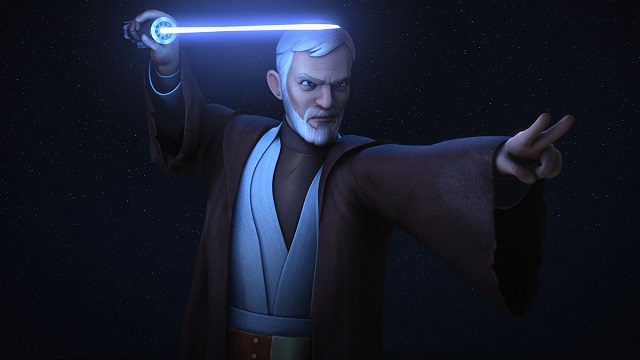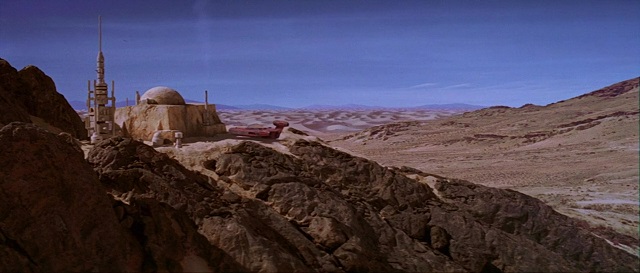
Like many Star Wars fans, I think it’s high time for us to have ourselves an Obi-Wan Kenobi movie. There are so many areas worth exploring with this character, some of which had been explored and then wiped clean by the Disney buyout. I know I’d personally love to see more stories that focused on Obi-Wan and Bail, Obi-Wan and Ahsoka, Obi-Wan and Satine, and Obi-Wan’s Padawan days – all stories that I’m interested for a variety of reasons.
Ultimately though, what most have been clamoring for is some Tatooine-based, post-Order 66 drama. And I cannot bring myself to disagree, especially since my two favorite pieces of Star Wars fiction take place in those years. “Twin Suns” is obviously off the potential-Kenobi-movie table, for a number of reasons, not the least of which would be the need for a digitized Alec Guinness Obi-Wan, à la Rogue One‘s Tarkin, for the entire movie. Additionally, “Twin Suns” functions first and foremost as an Ezra Bridger AdventureTM, which requires the context of Star Wars Rebels, and that’s not even getting into its deliberate parallels to previous episodes in the show or the intense symbolism from The Clone Wars.
Kenobi however…now there’s some ripe pickings for a movie.
The Legends novel by John Jackson Miller takes place shortly after Obi-Wan’s arrival on Tatooine and his delivery of Luke to the Lars homestead. While it’s only sparingly told from Obi-Wan’s perspective, the things he says and does, and the things he does not say or do, along with the parallels to other characters’ lives, all manage to paint a perfect picture of how he is coping with the aftermath of Order 66 and Anakin’s betrayal. The stakes in which he finds himself involved are on a distinctly small-scale – the internal drama of a moisture-farming community – but it all becomes a reflection of the fall of Anakin and the fall of the Republic. The pieces that we do receive from Obi-Wan’s point of view are his meditations with Qui-Gon Jinn. From there we see how he’s struggling with Anakin’s betrayal, his own failures, and the need to set aside his Jedi mantle for the time being.
While I don’t expect Lucasfilm to pluck the plot wholesale from Miller’s novel, there are core elements of the story that deserve to be realized on the silver screen.
All of the films since the original trilogy was released, have been, in some way, a commentary on previous Star Wars media. The prequels were meant to mirror and rhyme with the originals. The sequels have taken an even harder turn into the meta by deconstructing and reconstructing mainstays of the franchise. The anthology films are focused on providing new context to events or characters with which we already are familiar. Therefore, Miller’s decision, to have his conflict reflect the Clone Wars on a far smaller and more intimate scale, fits in perfectly with the de/reconstructional tone of the current films.
Miller’s other decision – to have Obi-Wan struggle with his purpose as a Jedi in the midst of that conflict, and eventually choose a better path than he and his Order did in The Clone Wars – would also fit in with the meta tone, but more importantly it would provide his character arc for the movie.

If you’ll pardon the “Twin Suns” reference – I have a hard time shutting up about that episode – there is a moment in which Obi-Wan instinctively strikes the lightsaber pose he used in Revenge of the Sith, reacting to a threat in the same way that General Kenobi would. But the problem there is that the Clone Wars, the Jedi taking up ranks as generals, was all a trap. It forced the Jedi to abandon their ideals on more than one occasion, forced them to operate with an us-versus-them mentality in scenarios where they used to be arbiters of peace. After a moment of reflection in “Twin Suns”, however, Obi-Wan shifts instead to the pose we know from A New Hope. This indicates that he has grown past the general he once was and has become again what a Jedi ought to be, using the Force for knowledge and defense, not attack.
A smaller scale conflict that reflects the Clone Wars will allow us to see Obi-Wan himself reflect on his actions in the war. We will get to see his first steps on his journey to leave the rank and mindset of “general” behind.
Another aspect that was crucial to Obi-Wan redefining what it meant for him to be a Jedi was his meditations with Qui-Gon Jinn. In the novel, Obi-Wan hasn’t quite been able to connect with his former master, and thus the meditations act more as a means to give us insight into Obi-Wan’s emotional and mental state.
Transforming these meditations into actual conversations between Obi-Wan and Qui-Gon would be a solid decision for a couple of reasons. The first of which is the change in medium. One of the few changes that the recent Hobbit movies made for the better was removing Bilbo’s invisibility during the conversation with Smaug. While the exposition in the book established the threat of simply being in Smaug’s presence, Ring or no, it was a type of threat not easily transferable to the screen. Making Bilbo visible to Smaug used the strengths of the new medium properly to convey the same looming presence and sense of entrapment.
Similarly, it’s hard to translate internal thoughts explicitly onto the screen, especially ones as direct and specific as Obi-Wan’s meditations. Having an actual dialogue with Qui-Gon, even if he has not yet achieved the physical manifestation he displayed in From a Certain Point of View, would use the audiovisual medium effectively. What’s more, having Qui-Gon abruptly end the conversations, leaving Obi-Wan talking to himself would keep the sense of loneliness that pervades much of what we’ve seen in Obi-Wan’s life on Tatooine.

The other reason for Obi-Wan’s meditations to be transformed into a dialogue between master and student is for the sake of worldbuilding. The Force is always going to be a fantastic concept to explore, but most of the larger-scale revelations we receive about the Force are accompanied by big, bombastic, and weird displays. The Mortis trilogy, Yoda’s Force journey in season six of The Clone Wars, Maul’s survival, the Jedi temple on Lothal, Luke’s showdown on Crait.
Don’t get me wrong; I love each and every one of those moments. I love when Star Wars embraces the weird. That’s part of what makes it good science fiction. But Star Wars also thrives on the smaller actions. Anakin doesn’t draw Qui-Gon’s attention because he performed some miraculous feat with the Force. He draws it because he showed compassion in defending Jar Jar and offering them shelter. Luke’s iconic moment as a Jedi isn’t his destruction of the first Death Star. It’s him throwing his lightsaber away on the second. Finn’s critical turning points as a character don’t happen after seeing a grand gesture of the Resistance. They happen because he sees individual people suffering and dying. As such, it would be fitting that the final piece of the greatest training a Jedi ever receives – how to live after death – would come not through a grand, planet-hopping adventure, but through an intimate dialogue between friends.
This small-scale setting of Kenobi allows for that intimacy, both in relationships and character developments. In his review of the novel, Mike Cooper describes the conflicts of the other main characters – Annileen, Orrin, and A’Yark – as “just shy of being a great big shadow play inside [Obi-Wan’s] mind.” The intimate setting and the smaller cast, however, keep these characters from being just metaphors to reflect Obi-Wan’s internal state. They are fully-realized, which makes the stakes, small though they are,feel important.
Speaking of the cast, another good page to pull from Kenobi would be the number of women in major and minor roles. There are a few colorful characters in smaller roles, but the major roles are split 50/50 between men and women. And since Kenobi does pull heavily from the Western genre, it wouldn’t be too far off the mark for the movie to cast these roles in a way that reflects the racial diversity in real western times, much in the same way that the Magnificent Seven remake did in 2016.
There are still countless other stories I would like to see with Obi-Wan Kenobi, all across his life. But nearly every other point in his life would require a grand scale to explore. Even before the Clone Wars, even before he began training Anakin, Obi-Wan was still attached to the Jedi Order in the glory days of the Republic. Intimacy can be hard to grasp in that vastness within the confines of a single movie, and I think that a small-scale film would be a good move for Star Wars. This is a franchise where the greatest actions are defined by the smallest decisions of courage and compassion. It would be a fine thing to live in the intimacy of those decisions for the course of an entire film, and the reflections and “shadow plays” in Kenobi are the perfect place to explore the intimate that will affect the grand.

This could be interesting. If the did an “Obi-Wan on Tatooine” movie, I would hope that it would also find ways to differentiate itself from JJM’s Legends work. Too much of the New Canon has involved recycling Legends material for my tastes. I agree that “Kenobi” would be an important resource for any future Obi-Wan movie, but I would hope it would also find ways to be different, while still being enjoyable (a fine line to tread).
For my money, one of the most under-examined relationships in Star Wars is Obi-Wan and Bail Organa. The original movie sets them up as being close associates and brothers-in-arms, but the Prequels totally failed (in my mind) on capitalizing on that relationship. A McGregor and Smitts movie would be pretty sweet, though I imagine that Lucasfilm would be hesitant to revisit the Prequels in a major movie project.
I agree. I feel like the Legends novel Wild Space by Karen Miller (and then her next novel Gambit: Stealth) did an excellent job of establishing why they trust each other so much, even in the aftermath of Order 66.
While I’m not looking for a retread of Wild Space, I do think we need an exploration of that relationship. Plus, there is no such thing as too much Jimmy Smitts.